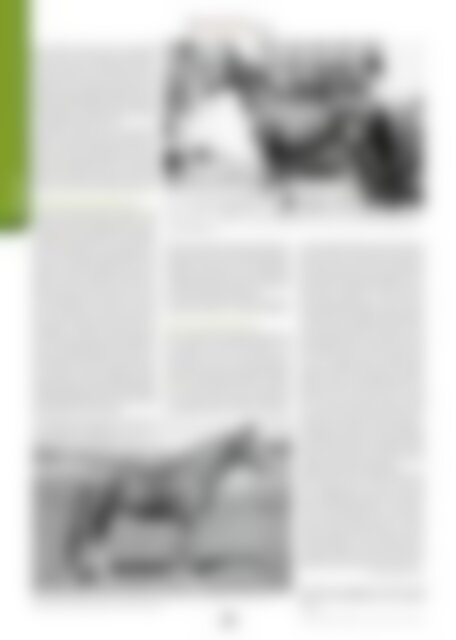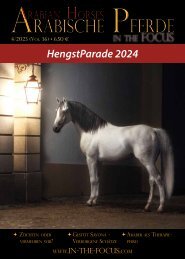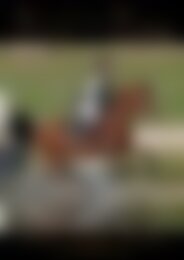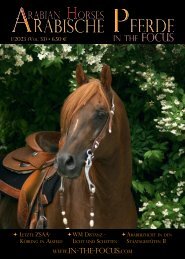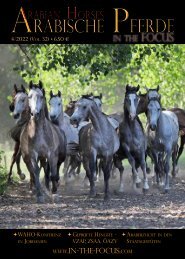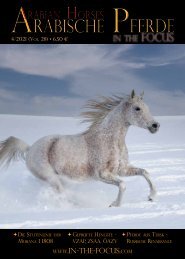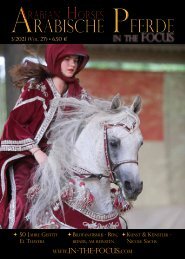Arabische Pferde IN THE FOCUS 2/2022 (Vol. 30) - public
Zeitschrift für Liebhaber und Züchter arabischer Pferde
Zeitschrift für Liebhaber und Züchter arabischer Pferde
Erfolgreiche ePaper selbst erstellen
Machen Sie aus Ihren PDF Publikationen ein blätterbares Flipbook mit unserer einzigartigen Google optimierten e-Paper Software.
Zucht<br />
go to London. He even wants to take Komet<br />
with him there.” Was his interest in the Arabian<br />
horse aroused here at Achental? Zichy-Thyssen<br />
later became the owner of El Shaklan in Argentina!<br />
And also Dr. Tienemann from the Zoo in<br />
Duisburg came to Achental to look for foals: "He<br />
was given a noble Egyptian stallion for the zoo,<br />
Kaisoon by Nazeer, with whom he would like to<br />
have offspring.” Ultimately, Kheman, Koratah<br />
and Koranah moved to Duisburg.<br />
The Griesbach children were very fortunate to<br />
be able to travel long distances abroad for their<br />
mother's company. Irmelin always took this opportunity<br />
to visit some Arab studs. So she travelled<br />
to France, England and the USA. One of her<br />
many trips abroad also took her to Argentina.<br />
There she met her future husband and in 1956<br />
the young veterinarian moved to South America.<br />
Childhood dream comes true<br />
In 1962, Gertraude Griesbach finally had the<br />
opportunity to purchase a black stallion, which<br />
she had wanted since childhood. In fact, two Polish<br />
stallions, Borys (by Wielki Szlem) and Bibars<br />
(by Witraz), both black, were for sale. Dr Skorkowski<br />
in Kraków had recommended Bibars to<br />
her and it was a happy coincidence that it was<br />
possible to acquire the stallion from the Swiss<br />
national circus Knie: Freddy Knie wanted to establish<br />
a group of black horses but could not<br />
find any other blacks. That was the only reason<br />
why he separated from the stallion. In the same<br />
year, Mrs. Griesbach sent a group of six young<br />
mares and the stallion Kassam (by Wisznu) to<br />
her daughter in Argentina. At that time, such a<br />
transport was not a matter of hours by plane, it<br />
was a week-long ship passage. Nevertheless, the<br />
horses survived the journey in the narrow transport<br />
boxes and arrived safely in the sunny south.<br />
The foundation mares of the Argentine Achental<br />
stud were the Wisznu daughters Kasserah<br />
(Khabitha family), Jowiszah (Jacaranda family),<br />
Iminah (Isabell family), Korima (Kho-Rha family)<br />
and Rubayyah (Rozka family) as well as the Kalif<br />
daughter Kokah (Comtesse family).<br />
Karim (Wisznu / Kaira) 1959 - grandson of Kalif (below). - Karim ist ein Enkel des Hengstes Kalif<br />
(unten abgebildet).<br />
There was a horse from (almost) every mare family<br />
to continue the lines in distant Argentina.<br />
In addition, there was the self-bred Kassam (by<br />
Wisznu), who was used as a sire in Argentina's<br />
Achental for many years. Later the mares Isabell<br />
II (Isabell family) and Jadah (Jemen family) as<br />
well as Bibars followed to Argentina.<br />
In January 1964 the first foals of the Argentine<br />
Achental stud was born - but back to Germany.<br />
The stud closes the gates<br />
Here in Germany, Mrs. Griesbach decided with<br />
a heavy heart to completely liquidate her stud<br />
farm Achental. On this occasion there was a<br />
farewell party: “And how many breeders and<br />
friends were there when our purebred Arabians<br />
were dancing and prancing in glorious weather!<br />
Of course I can also believe that it was a sad day<br />
for you: after 20 years you are now giving up<br />
your purebred Arabian breeding. Although the<br />
most beautiful horses are with me (in Argentina)<br />
and I hope they thrive here just as well as in<br />
Germany with you. But you only see them here<br />
when you visit me. And with the German breeders<br />
who buy them from you, you will also be<br />
able to follow their further development. So it's<br />
good that you sold almost all of them to Ismers,<br />
eight heads, including the fertile Rualla and<br />
the beautiful Inazzah [note. i.e. Red.: as well as<br />
Comtesse, Wiszkha, Kowiszkah, Iborah, and the<br />
stallion Borys], you lend them your beloved Wisznu,<br />
yes, they can be happy that they will now<br />
also breed Arabian horses in addition to their<br />
pony breeding. And you sold the young colt Rih<br />
to Mr. Dömken, whom you value so much, and<br />
he was very happy. Jemen's daughter Jekah<br />
will come to Habbes after you sent me Jekah's<br />
daughter Jadah. It was probably very effective<br />
that you were able to show the audience what<br />
Arabians can do and what they can be used<br />
for! First of all, they are bred to have a reliable,<br />
clever, healthy and enduring riding horse that<br />
will never let you down, that will carry you through<br />
nature, that will be a good companion.<br />
And that gives you foals. You can also harness<br />
your Arabian and they will trot forward steadily<br />
without tiring. Driving is a wonderful, but not<br />
easy sport and mastering teams of four and five<br />
is difficult. We tried it out thoroughly.”<br />
With that, the first larger purebred Arabian stud<br />
farm closed its doors in 1964. Six mares from<br />
the old Hungarian lines could be saved after<br />
the Second World War thanks to the committed<br />
efforts of Gertraude Griesbach - all of them, as<br />
well as the two Marbach mares and the Polish<br />
Isonda, became important pillars of German<br />
Arabian breeding. Their lines have survived to<br />
this day through the 167 foals that were born<br />
in Achental between 1947 and 1964. The breeding<br />
history of Germany has thus set Gertraude<br />
Griesbach and her work a worthy monument.<br />
Gudrun Waiditschka<br />
Kalif (Halef / Khabitah) 1948, the first self-bred breeding stallion at Achental. - Kalif, der erste<br />
selbst gezogene Zuchthengst im Gestüt Achental.<br />
The article first appeared in Araber Journal<br />
6/1991 and is reproduced here in an extended<br />
version.<br />
20<br />
© ARABISCHE PFERDE - <strong>IN</strong> <strong>THE</strong> <strong>FOCUS</strong> 2/<strong>2022</strong>


